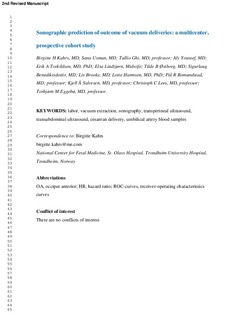| dc.contributor.author | Kahrs, Birgitte Heiberg | |
| dc.contributor.author | Usman, Sana | |
| dc.contributor.author | Ghi, Tullio | |
| dc.contributor.author | Youssef, Aly | |
| dc.contributor.author | Torkildsen, Erik Andreas | |
| dc.contributor.author | Lindtjørn, Elsa | |
| dc.contributor.author | Østborg, Tilde Broch | |
| dc.contributor.author | Benediktsdóttir, Sigurlaug | |
| dc.contributor.author | Brooks, Lis | |
| dc.contributor.author | Harmsen, Lotte | |
| dc.contributor.author | Romundstad, Pål Richard | |
| dc.contributor.author | Salvesen, Kjell Å | |
| dc.contributor.author | Lees, Christoph | |
| dc.contributor.author | Eggebø, Torbjørn Moe | |
| dc.date.accessioned | 2017-10-20T12:13:52Z | |
| dc.date.available | 2017-10-20T12:13:52Z | |
| dc.date.created | 2017-09-21T11:06:42Z | |
| dc.date.issued | 2017 | |
| dc.identifier.citation | American Journal of Obstetrics and Gynecology. 2017, 217 (1), 69.e1-69.e10. | nb_NO |
| dc.identifier.issn | 0002-9378 | |
| dc.identifier.uri | http://hdl.handle.net/11250/2461295 | |
| dc.description.abstract | Background
Safe management of the second stage of labor is of great importance. Unnecessary interventions should be avoided and correct timing of interventions should be focused. Ultrasound assessment of fetal position and station has a potential to improve the precision in diagnosing and managing prolonged or arrested labors. The decision to perform vacuum delivery is traditionally based on subjective assessment by digital vaginal examination and clinical expertise and there is currently no method of objectively quantifying the likelihood of successful delivery. Prolonged attempts at vacuum delivery are associated with neonatal morbidity and maternal trauma, especially so if the procedure is unsuccessful and a cesarean is performed.
Objective
The aim of the study was to assess if ultrasound measurements of fetal position and station can predict duration of vacuum extractions, mode of delivery, and fetal outcome in nulliparous women with prolonged second stage of labor.
Study Design
We performed a prospective cohort study in nulliparous women at term with prolonged second stage of labor in 7 European maternity units from 2013 through 2016. Fetal head position and station were determined using transabdominal and transperineal ultrasound, respectively. Our preliminary clinical experience assessing head-perineum distance prior to vacuum delivery suggested that we should set 25 mm for the power calculation, a level corresponding roughly to +2 below the ischial spines. The main outcome was duration of vacuum extraction in relation to ultrasound measured head-perineum distance with a predefined cut-off of 25 mm, and 220 women were needed to discriminate between groups using a hazard ratio of 1.5 with 80% power and alpha 5%. Secondary outcomes were delivery mode and umbilical artery cord blood samples after birth. The time interval was evaluated using survival analyses, and the outcomes of delivery were evaluated using receiver operating characteristic curves and descriptive statistics. Results were analyzed according to intention to treat.
Results
The study population comprised 222 women. The duration of vacuum extraction was shorter in women with head-perineum distance ≤25 mm (log rank test <0.01). The estimated median duration in women with head-perineum distance ≤25 mm was 6.0 (95% confidence interval, 5.2–6.8) minutes vs 8.0 (95% confidence interval, 7.1–8.9) minutes in women with head-perineum distance >25 mm. The head-perineum distance was associated with spontaneous delivery with area under the curve 83% (95% confidence interval, 77–89%) and associated with cesarean with area under the curve 83% (95% confidence interval, 74–92%). In women with head-perineum distance ≤35 mm, 7/181 (3.9%) were delivered by cesarean vs 9/41 (22.0%) in women with head-perineum distance >35 mm (P <.01). Ultrasound-assessed position was occiput anterior in 73%. Only 3/138 (2.2%) fetuses in occiput anterior position and head-perineum distance ≤35 mm vs 6/17 (35.3%) with nonocciput anterior position and head-perineum distance >35 mm were delivered by cesarean. Umbilical cord arterial pH <7.10 occurred in 2/144 (1.4%) women with head-perineum distance ≤35 mm compared to 8/40 (20.0%) with head-perineum distance >35 mm (P < .01).
Conclusion
Ultrasound has the potential to predict labor outcome in women with prolonged second stage of labor. The information obtained could guide whether vacuum delivery should be attempted or if cesarean is preferable, whether senior staff should be in attendance, and if the vacuum attempt should be performed in the operating theater. | nb_NO |
| dc.language.iso | eng | nb_NO |
| dc.publisher | Elsevier | nb_NO |
| dc.rights | Attribution-NonCommercial-NoDerivatives 4.0 Internasjonal | * |
| dc.rights.uri | http://creativecommons.org/licenses/by-nc-nd/4.0/deed.no | * |
| dc.title | Sonographic prediction of outcome of vacuum deliveries: a multicenter, prospective cohort study | nb_NO |
| dc.type | Journal article | nb_NO |
| dc.type | Peer reviewed | nb_NO |
| dc.description.version | acceptedVersion | nb_NO |
| dc.source.pagenumber | 69.e1-69.e10 | nb_NO |
| dc.source.volume | 217 | nb_NO |
| dc.source.journal | American Journal of Obstetrics and Gynecology | nb_NO |
| dc.source.issue | 1 | nb_NO |
| dc.identifier.doi | 10.1016/j.ajog.2017.03.009 | |
| dc.identifier.cristin | 1496319 | |
| dc.description.localcode | © 2017. This is the authors’ accepted and refereed manuscript to the article. LOCKED until 19.3.2018 due to copyright restrictions. This manuscript version is made available under the CC-BY-NC-ND 4.0 license http://creativecommons.org/licenses/by-nc-nd/4.0/ | nb_NO |
| cristin.unitcode | 194,65,15,0 | |
| cristin.unitcode | 194,65,20,0 | |
| cristin.unitname | Institutt for klinisk og molekylær medisin | |
| cristin.unitname | Institutt for samfunnsmedisin og sykepleie | |
| cristin.ispublished | true | |
| cristin.fulltext | original | |
| cristin.qualitycode | 2 | |

